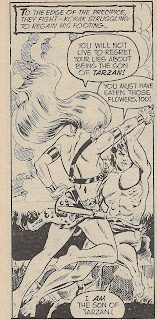Sunday, July 28, 2024
Korak in Sunday Tarzans (11/20/1977)
Sunday, July 21, 2024
Korak in Sunday Tarzans (11/13/1977)
Previous blog: Korak in Sunday Tarzans (11/6/1977)
This blog is intended to raise interest in and appreciation of the Edgar Rice Burroughs character Korak. To see this story in context, you may find it in Hillman's ERBzine at the following link:
Sunday, July 14, 2024
Korak in Sunday Tarzans (11/6/1977)
Previous Sunday Tarzan blog: Korak in Sunday Tarzans (10/30/1977)
This blog is intended to raise interest in and appreciation of the Edgar Rice Burroughs character Korak. To see this story in context, you may find it in Hillman's ERBzine at the following link:
Korak in British Tarzans (Nov. 1977) - Golden Girl
As the star of his own comic book series in 1964, Korak is a capable, young hero. His adventures were somewhat similar to those of his father Tarzan, but independent from them.
He continues to be an intelligent, enthusiastic teen-aged boy with good natural instincts and a good heart. His youthful inexperience makes him vulnerable to dirty fighting techniques or seduction. His youthful enthusiasm may also lead him into trouble over good but dangerous causes or to otherwise confront dangerous opponents to prove himself.
Korak in British Tarzans (Nov. 1977) - Jewel of Thobos
As the star of his own comic book series in 1964, Korak is a capable, young hero. His adventures were somewhat similar to those of his father Tarzan, but independent from them.
He continues to be an intelligent, enthusiastic teen-aged boy with good natural instincts and a good heart. His youthful inexperience makes him vulnerable to dirty fighting techniques or seduction. His youthful enthusiasm may also lead him into trouble over good but dangerous causes or to otherwise confront dangerous opponents to prove himself.





































